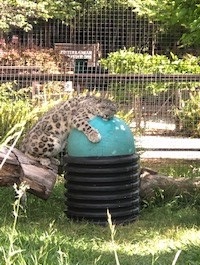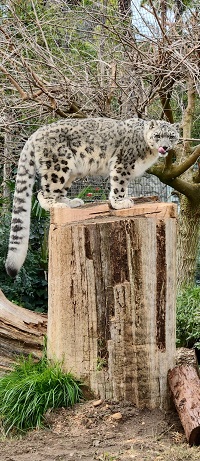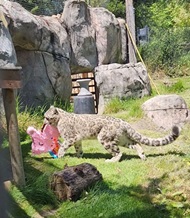Snow Leopard
Panthera uncia
- Habitat: Alpine habitat along the Mongolian and Tibetan Plateau
- Range: High mountains in Central Asia (Afghanistan, Bhutan, China, India, Kazakhstan, Kyrgyzstan, Mongolia, Nepal, Pakistan, Russian Federation, Tajikistan, and Uzbekistan)
- Natural Diet: Mountain goats (Himalayan tahr and markhor), sheep (bharal and argali), young yak, hares, and birds
- Status in the Wild: THREATENED
All About the Snow leopard
The snow leopard is closely related to other big cats such as the African lion and the Royal Bengal tiger. Since they live in colder climates, they sport thick fur that is whitish-grey in color with black rosettes. Their beautiful coats are good camouflage in their snow-bound habitat and help them hide in the surrounding landscape. They have shorter snouts when compared to other big cats with a short stocky body and short legs. Their long thick fur helps them stay warm during the freezing winters of their habitat. Their tails are much longer than other big cats and help them balance when they climb steep mountainsides and cliffs. Their tails also help them stay warm during the winter months. Snow leopards have large paws with thick fur that helps them move on heavy snow. The thick fur helps keep their feet warm and protects them from injuries when they move on sharp surfaces.
They are around 2 feet in height and 5 feet long while with their tails alone measuring about 3.5 feet. Their weight ranges from 50 to 125 lb. Males and females are of the same size.
Diet/ Habitat/ Range
Snow leopards are found in Central Asia where they live in alpine habitats in the Mongolian and Tibetan plateaus.
Snow leopards only feed on meat and are called obligate carnivores. In the wild, they feed on mountain goats (Himalayan tahr and markhor), sheep (bharal and argali), young yak, hares, and birds
Behavior
Similar to other big cats, snow leopards defend a territory within which, they hunt and feed, rest, and have young. The territories of males are considerably larger than those of females and overlap significantly. While the males spend their time surveying their territories and protecting their females and offspring, from competitors, females focus on taking care of and training their offspring.
Snow leopards are ambush predators which means they hide and ambush their prey when they are out hunting. All big cats use this technique.
Snow leopards emit a range of vocalizations; they chuff, mew, growl, moan, howl, hiss, and yowl. However, they do not growl like other big cats because of the physiology of their throats. Big cats have a well-developed and specifically designed larynx and hyoid apparatus that they use to emit low rumbling sounds that are initiated before they roar. Their biological rhythm is similar to that of other big cats. They are either active by night (nocturnal) or at dawn and at dusk (crepuscular). Their biological rhythm helps them increase their hunting success by hunting when their prey sleep. Snow leopards are adept climbers moving effortlessly across cliff faces and rocky outcrops. They have well-built muscular fore and hind legs that help them climb.
Reproduction
Snow leopards live solitary lives only pairing up during the breeding season during fall and winter. During the breeding seasons, males follow the scent marks left by the females in their territories to find females that are in estrus. If the female is interested in mating, she initiates a reproductive behavioral sequence by directing calls to the male, rubbing against objects, and rolling on the ground. Males and females spend several weeks together during the breeding season with the males pairing up with multiple females.
The cubs are born in late spring or early summer. Female snow leopards deliver two to three cubs and are weaned when they are around 2.5 to 3 months old. Cubs disperse from their mothers when they are around 2 years of age. During those 2 years, the cubs are trained to maintain their territory, hunt, communicate, and take care of their young.
Conservation/Status
Snow Leopards are categorized as VULNERABLE by the World Conservation Union because of depleting numbers, loss of habitat, human habitation, and reduced number of prey. Another significant concern is the illegal hunting of this species for its fur.
The Association of Zoos and Aquariums (AZA) is focused on conserving snow leopards through their Species Survival Plan (SSP). Zoos across the United States, Canada, and Mexico are involved in their program and several are selected to breeding their felids to increase the snow leopard population in the zoo community. AZA’s SSP is also linked with other zoos globally and several individuals have been moved internationally to add new genes to increase genetic diversity. AZA also focuses on conserving snow leopards by being a part of the Wildlife Trafficking Alliance. Through this alliance they work with their partners to reduce, and eventually eliminate, the illegal trade of wildlife and wildlife products



